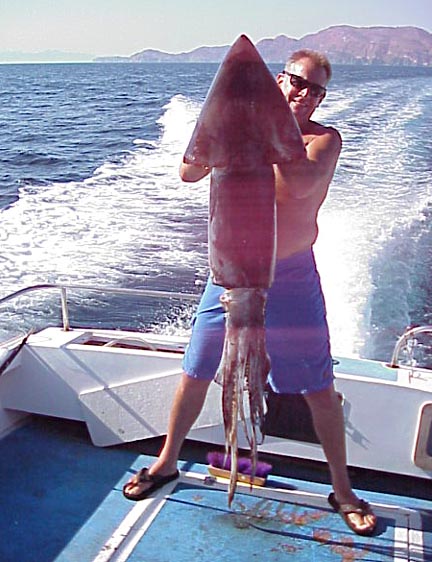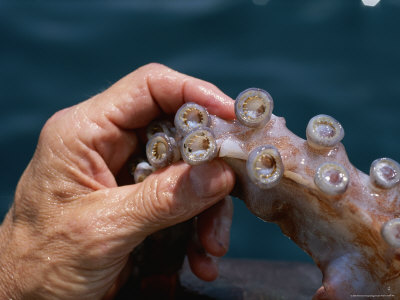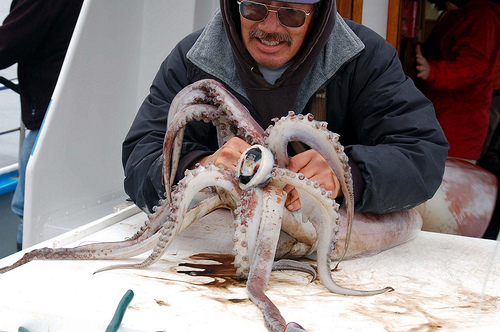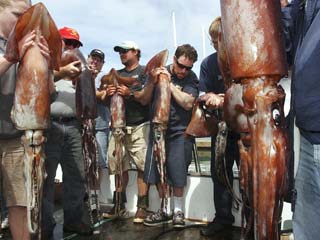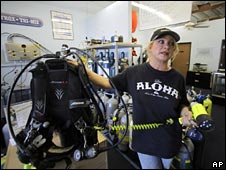Humboldt Squid: Intelligent,Attack Predator.
This is a 70-pound specimen caught off Cabo San Lucas
Click thumbnail to view full-size





Locals say squid seem curious
“Curious” Squid Cause Panic in California.
The news this summer of the arrival of hundreds of Humboldt Squid in California will no doubt lead to a spate of movies a-la-Jaws, to add to one we already have. The squid is also known as "Jumbo Squid," Jumbo Flying Squid," and "Diablo Rojo." (Red Devil Sp.). Although the species has traditional been found further south; the California excursion is nothing new, the large “Dosididicus gigas” has been found in deep waters all along the US western states as far as Alaska for some years. In fact, it seems the squid are no happier about being trapped in shallow water and waves than swimmers are. In 2005, hundreds of dead and dying squid were removed from the beaches around San Diego.
It’s common name, “Humboldt Flying Squid,“ comes from it’s natural habitat in deeps where the 600-mile-wide Humboldt Current flows, miles offshore in the Pacific ocean, northwards along the Chilean and Peruvian coastlines. This current, and its plankton-rich upswellings, is responsible for providing much of the squid's food fish in these areas. The Humboldt itself is subject to many variations in its effects annually and may play a far greater part than we really understand on the movements of these huge creatures. The squid are rarely seen or caught by non-specialists, as it is a deep water denizen by nature, only venturing closer to the surface at night to feed.
There are reports, which I suspect are greatly exaggerated, about those occupying waters off San Diego. Divers have said they have been “roughed up” by the squid, tearing at their face masks, scuba tanks and flippers, etc. Many professional divers won’t swim with the “cephalopods,” one saying, “neither would he walk among lions on the Serengeti!”
Squid are seen by many scientists as being rather intelligent animals who also communicate and hunt in large groups. It’s feasible they are escaping intensive fishing in Mexico, Central American states and countries such as Peru, or that their prey in those areas are so denuded by fishing and ecology issues they need to venture further afield into shallow water..
The Humboldt squid has been associated with verified and documented attacks on human divers and fishermen. So much so, that the creature as known as the “Red Devil” in Mexico. (see red and white flashing below). But it seems such attacks on divers are not gratuitous in nature and are either associated with nighttime feeding; defensive wounding or, perhaps, curiosity. (deep sea cameras have been reported as having been destroyed by squid and the “attacks“ this week in San Diego would seem more curious than overtly aggressive). In fact, many divers have commented on the squid's gentle nature, but the same has been said about sharks and it would seem that predators of many species do possess characters capable of much violence when defending themselves or feeding, and affectionate curiosity at other times. Bit like us, I suppose.
If a squid wants to get nasty it is well equipped by nature to do so. It has a very powerful beak used for tearing flesh, tissue and light bone. But it is the two tentacles, each tipped with several large sucker “mouths” ringed with teeth, that strike fear into the squid’s prey and to the few humans who have seen them in operation. The squids hunting method is to swim very fast, along with others, expelling water in a syphon system which can propel the creature up to 25 kilometers an hour. It holds all its ten tentacles before it in a cone-shaped bunch. This is probably to streamline the unwieldy grasping tentacles. When an attack on prey in imminent, the squid opens the other eight tentacles allowing the attacking pair to fly out and grasp the fish or other prey. It then hauls the prey in until it can repeatedly slash it with its beak, killing and devouring it. Squid work together in killing and disposing of large prey.
These squid are hunted at certain times of the year in Mexico by fishermen in 18-foot-long Pangas, or launches. They motor out to the fishing grounds some four miles off shore in the Sea of Cortez where a heavy corked “long line” containing several hundred hooks baited with lumps of bait fish is thrown overboard. During these times, it would seem the squid are operating much nearer the surface.
The squid are cleaned in situ and sold in the local market for pennies per kilo to residents, and middle men who sell them on to other markets. The squid, known as “calamar” are not that easy to catch, are dangerous to handle, and the quotas enforced by Mexican government prevent the fishermen making a decent living. Mexicans tell of the squid's ability to change color, flashing white and red when hooked. Experts say they may be communicating in this manner. But the Humboldt can be a turncoat in more than just color, as there are many reports of cannabalism, usually by a much larger squid upon a smaller. The creatures are also seen as the main food source of Sperm Whales. As few of these huge mammals inhabit Pacific waters off the United States, there is speculation that the squid may have less narural predation by whales or man away from Mexico and South America. Their proliferation further north also bodes ill for many of the squid's prey fish in these areas, such as young salmon and the smaller fish on which the salmon feed.
It appears many sea creatures are changing their “normal” modus operandi of living and feeding. Look at all the reports we see of schools of whales and porpoises apparently committing mass suicide. No doubt the true explanation is they are driven by starvation or contamination of their habitat.
It is also interesting to reflect that El Nino conditions are developing strongly this year and expected to cross over to northern areas sometime between July and September, 2009. El Nino has had profound effects in the past on climate, wind systems and storm patterns, etc. In turn, these affects have been passed on all through the ecosystems, causing, or contributing to, unusual behavior in many sea creatures, from the increase in poisonous algae, to mass starvation of species. This may well have something to do with the strange behaviour of the squid.
The one and only danger man faces is if any species with the ability to do us serious harm organizes itself to do so. This is as true of the ant as it is of any sea creature. Meanwhile, there have been no deaths I am aware of due to squid attack, neither am I aware of really serious injuries as a direct attack by beak or toothed sucker. So, Hollywood, get the imagination going. The average mature Humboldt Squid only weighs-in at around 100 pounds. Have to up that by, say, 2 tons for the screen denizen? Then no one will go swimming any more!

